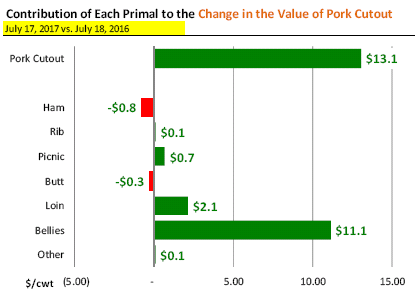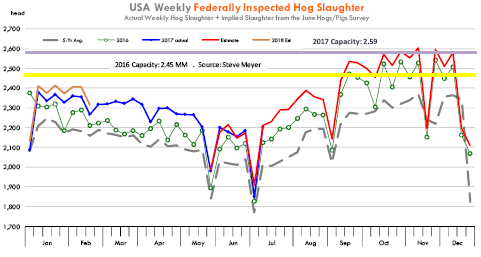



CME: Grilling Demand Waning; Hog Supplies to Increase
US - With the July Lean Hog futures contract off the board, there is now a roughly $12 spread between the cash index and the nearby August contract, reports Steiner Consulting Group, DLR Division, Inc.It is a hefty discount that reflects market participant apprehension/concern about the sustainability of current lofty wholesale pork prices.
Grilling demand starts to wane and hog supplies will seasonally increase in the next four weeks. But first its good to put in perspective what has been driving the pork cutout to this point.
The record high belly prices certainly get all the press and for good reason. The pork cutout last night closed at $104.19/cwt, +$13 (14.3 per cent) higher than a year ago.
Roughly $11 of that $13 gain in the value of the cutout is due to the rise in pork belly price. The belly primal value last night was $208.47/cwt, 51 per cent higher than a year ago and another all-time record high.
Needless to say, much of the guessing game, and we think the reason for the discount into August, has to do with the outlook for bellies.
Yes, consumers like bacon and at the right price will eat plenty of it but one should also recognize that there is a lag between the time wholesale prices move up and when those higher costs are reflected in the final retail price.
The following chart shows the relationship between the retail bacon feature price (as reported in the USDA pork retail report) and the value of the pork belly primal.

Retail prices have been lagged by six weeks, in other words, the current retail price of bacon corresponds to the wholesale pork belly primal value six weeks ago.
One way to read the chart is that based on current wholesale values, we could see average retail bacon feature prices jump to around $5.50 by the end of August, a 16 per cent increase from current levels.

If you are a pork producer, current high pork prices are certainly welcome. They are evidence of excellent domestic demand and very robust pork export flow in the first six months of the year.
The risk, however, is that the sharp spike in belly prices may impact how foodservice market participants react for the next 6-9 months.
Maybe they see this for what it is - a short term spike that does not warrant menu changes or changes to product specs.
This is critical as pork supplies are expected to hit all-time record highs this fall and the market needs all the help it can get.
But bellies are not the only item that is contributing to the value of the cutout. The pork loin cutout in the last two weeks has followed a different trajectory than it did a year ago.
High beef prices in May and June have put in stark contrast the value that pork loins present, especially now that some of the low priced beef features have come to an end.
While loins were generally weak for much of last July and August, in past years we have seen loin prices hold up well until Labor Day.
Much will depend on the rate of slaughter in the next three weeks. Our expectation is for hog slaughter to 2.2 million head again this week and then approach 2.3 million by the first week of August.
The projections in the chart below were made using the latest USDA Hogs and Pigs report and one can see how quickly hog slaughter is expected to ramp higher into the fall.

Lower prices will be needed in order to help the market absorb this surge in pork supplies. We think maintaining the marketing pace and not allow hog weights to get out of control in Oct/Nov remains a key imperative for the hog market this fall.







